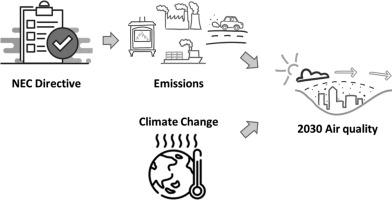Science of the Total Environment ( IF 9.8 ) Pub Date : 2020-12-03 , DOI: 10.1016/j.scitotenv.2020.143911 S. Coelho , S. Rafael , D. Lopes , A.I. Miranda , J. Ferreira

|
Air pollution is a global threat leading to large impacts on human health and ecosystems. In Europe, air quality remains poor in many areas, despite reductions in emissions and ambient concentrations. Air pollution and climate change are the biggest environmental concerns for Europeans, implying concerted and integrated actions to tackle them. The revised 2016 European National Emission Ceilings Directive (NECD) enforces Member States to implement strategies, based on emission reduction measures, aimed to comply with targets by 2030 and achieve European Union (EU) and World Health Organization air quality objectives for environment and health protection. Despite those strategies are designed for 2030, the influence of climate change on air quality is not accounted for. In this sense, the purpose of this paper is the evaluation of the climate change impact on future air quality, taking into consideration emission reduction measures. The WRF-CAMx air quality modelling system was applied over Europe for one year selected as representative of a short-term changing climate (around 2030), and compared to a base case year, to estimate to what extent the climate variables by themselves could positively or negatively influence air quality. Results indicate that meteorological conditions may be decisive for the air quality state in the future. Differences between future and present simulations pointed to a global decrease of ozone levels in the future; increases and decreases in particulate matter and nitrogen dioxide concentrations over different seasons and European regions.
This work is intended to contribute to a better understanding of the influence of climate variables on air quality improvement strategies as an additional support to European environmental authorities in developing the National Air Pollution Control Programmes in the scope of NECD.
中文翻译:

气候变化如何影响2030年的空气污染控制策略?
空气污染是全球性威胁,对人类健康和生态系统造成重大影响。在欧洲,尽管排放量和环境浓度有所降低,但许多地区的空气质量仍然很差。空气污染和气候变化是欧洲人最关注的环境问题,这意味着要采取协调一致的综合措施来解决这些问题。修订后的2016年《欧洲国家排放上限指令》(NECD)强制成员国实施基于减排措施的战略,旨在到2030年实现目标,并实现欧盟(EU)和世界卫生组织的环境和健康保护空气质量目标。尽管这些策略是针对2030年制定的,但并未考虑到气候变化对空气质量的影响。在这个意义上说,本文的目的是评估气候变化对未来空气质量的影响,同时考虑减排措施。WRF-CAMx空气质量建模系统在欧洲应用了一年作为短期气候变化的代表(大约2030年),并与基准年进行了比较,以估计气候变量自身可以在多大程度上产生积极影响或对空气质量产生负面影响。结果表明,气象条件可能对未来的空气质量状况起决定性作用。未来模拟与当前模拟之间的差异表明,未来全球臭氧水平将下降。不同季节和欧洲地区颗粒物和二氧化氮浓度的增加和减少。考虑减排措施。WRF-CAMx空气质量建模系统在欧洲应用了一年作为短期气候变化的代表(大约2030年),并与基准年进行了比较,以估计气候变量自身可以在多大程度上产生积极影响或对空气质量产生负面影响。结果表明,气象条件可能对未来的空气质量状况起决定性作用。未来模拟与当前模拟之间的差异表明,未来全球臭氧水平将下降。不同季节和欧洲地区颗粒物和二氧化氮浓度的增加和减少。考虑减排措施。WRF-CAMx空气质量建模系统在欧洲应用了一年作为短期气候变化的代表(2030年左右),并与基准年进行了比较,以估算气候变量自身可以在多大程度上产生积极影响或对空气质量产生负面影响。结果表明,气象条件可能对未来的空气质量状况起决定性作用。未来模拟与当前模拟之间的差异表明,未来全球臭氧水平将下降。不同季节和欧洲地区颗粒物和二氧化氮浓度的增加和减少。WRF-CAMx空气质量建模系统在欧洲应用了一年作为短期气候变化的代表(大约2030年),并与基准年进行了比较,以估计气候变量自身可以在多大程度上产生积极影响或对空气质量产生负面影响。结果表明,气象条件可能对未来的空气质量状况起决定性作用。未来模拟与当前模拟之间的差异表明,未来全球臭氧水平将下降。不同季节和欧洲地区颗粒物和二氧化氮浓度的增加和减少。WRF-CAMx空气质量建模系统在欧洲应用了一年作为短期气候变化的代表(2030年左右),并与基准年进行了比较,以估算气候变量自身可以在多大程度上产生积极影响或对空气质量产生负面影响。结果表明,气象条件可能对未来的空气质量状况起决定性作用。未来模拟与当前模拟之间的差异表明,未来全球臭氧水平将下降。不同季节和欧洲地区颗粒物和二氧化氮浓度的增加和减少。结果表明,气象条件可能对未来的空气质量状况起决定性作用。未来模拟与当前模拟之间的差异表明,未来全球臭氧水平将下降。不同季节和欧洲地区颗粒物和二氧化氮浓度的增加和减少。结果表明,气象条件可能对未来的空气质量状况起决定性作用。未来模拟与当前模拟之间的差异表明,未来全球臭氧水平将下降。不同季节和欧洲地区颗粒物和二氧化氮浓度的增加和减少。
这项工作旨在帮助人们更好地了解气候变量对空气质量改善策略的影响,作为对欧洲环境主管部门制定NECD范围内的《国家空气污染控制计划》的额外支持。


























 京公网安备 11010802027423号
京公网安备 11010802027423号